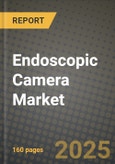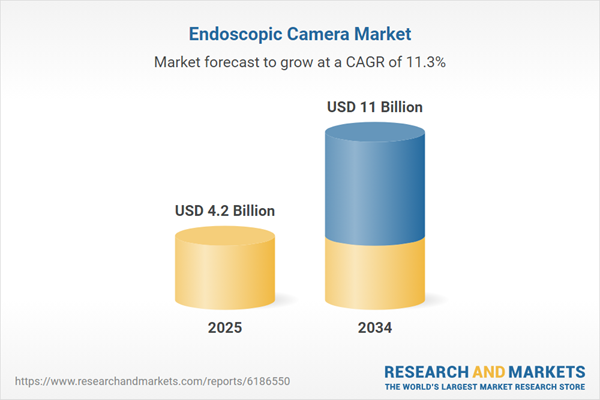Market Overview: Endoscopic Camera Market
The endoscopic camera market has witnessed significant growth due to the rising demand for minimally invasive surgical procedures across various medical fields, including gastroenterology, urology, orthopedics, and gynecology. Endoscopic cameras play a crucial role in providing high-resolution, real-time imaging, enabling surgeons to perform precise diagnostics and complex interventions with minimal patient trauma. Advances in high-definition (HD) and 4K imaging technologies have enhanced visualization capabilities, improving surgical outcomes and patient safety. Additionally, the increasing adoption of robotic-assisted endoscopy and AI-powered image processing is revolutionizing the field, offering enhanced precision and automation. The growing prevalence of gastrointestinal disorders, cancer, and age-related conditions has further fueled the demand for endoscopic procedures, boosting market expansion. Moreover, rising investments in healthcare infrastructure and the integration of wireless and capsule endoscopy technologies are broadening the scope of endoscopic camera applications.The endoscopic camera market experienced rapid advancements, driven by technological innovations and increased adoption of AI-assisted diagnostics. The growing preference for 4K and ultra-HD cameras improved image clarity, allowing for more accurate detection of abnormalities. AI-powered endoscopic systems gained traction, enabling automated lesion detection and real-time surgical guidance. Additionally, single-use and disposable endoscopic cameras saw increased demand due to concerns over infection control and cross-contamination risks. The shift towards portable and wireless endoscopic devices further enhanced accessibility, particularly in ambulatory surgical centers and remote healthcare settings. Regulatory approvals for advanced endoscopic imaging solutions facilitated market expansion, while the integration of fluorescence imaging and narrow-band imaging (NBI) improved diagnostic capabilities. The continued development of minimally invasive techniques, coupled with the rising number of endoscopic procedures worldwide, strengthened the market’s growth trajectory.
The endoscopic camera market is expected to witness further technological evolution, with the adoption of AI-driven real-time analytics, 3D imaging, and virtual reality integration. The increasing focus on precision medicine and personalized diagnostics will drive demand for advanced imaging solutions capable of detecting early-stage diseases with higher accuracy. The integration of robotics in endoscopic surgeries will continue to grow, enhancing precision, reducing procedural time, and minimizing patient recovery periods. Furthermore, the expansion of telemedicine and remote diagnostics will create new opportunities for wireless and cloud-connected endoscopic imaging systems. Sustainable and eco-friendly endoscopic camera designs, including biodegradable and reusable components, will gain attention due to the rising emphasis on environmental responsibility in healthcare. Emerging markets, particularly in Asia-Pacific and Latin America, will present significant growth potential, driven by healthcare modernization and increased access to advanced medical technologies. However, stringent regulatory compliance and cost-related challenges may impact market expansion, necessitating strategic collaborations and innovative pricing models.
Key Insights: Endoscopic Camera Market
- AI-Powered Endoscopic Imaging: The integration of artificial intelligence in endoscopic cameras is revolutionizing diagnostics by enabling automated anomaly detection, enhanced image processing, and real-time decision support. AI-driven endoscopy improves diagnostic accuracy, reduces human error, and enhances workflow efficiency in surgical procedures.
- Adoption of 4K and Ultra-HD Endoscopic Cameras: The demand for high-definition imaging continues to rise, with 4K and ultra-HD cameras offering superior clarity and detail. These advanced imaging solutions enhance the detection of small lesions and improve the overall quality of endoscopic procedures across medical specialties.
- Growth in Single-Use and Disposable Endoscopes: Concerns over cross-contamination and hospital-acquired infections have led to a surge in the adoption of single-use and disposable endoscopic cameras. These solutions ensure sterility, reduce maintenance costs, and eliminate the need for complex reprocessing procedures in healthcare facilities.
- Integration of Wireless and Capsule Endoscopy: Wireless endoscopic cameras and capsule endoscopy are gaining popularity for non-invasive gastrointestinal diagnostics. These technologies allow for real-time remote monitoring and improved patient comfort, making them ideal for early disease detection and long-term monitoring.
- Advancements in Fluorescence and Narrow-Band Imaging (NBI): The incorporation of fluorescence imaging and narrow-band imaging in endoscopic cameras enhances visualization of blood vessels and mucosal structures. These innovations improve the early detection of cancerous and precancerous lesions, contributing to better patient outcomes.
- Rising Demand for Minimally Invasive Surgeries: The increasing preference for minimally invasive procedures in gastroenterology, urology, and orthopedics is driving demand for advanced endoscopic cameras. These procedures reduce hospital stays, lower surgical risks, and improve patient recovery times.
- Growing Prevalence of Gastrointestinal and Chronic Diseases: The increasing incidence of gastrointestinal disorders, colorectal cancer, and other chronic conditions is fueling the demand for endoscopic procedures. Endoscopic cameras play a crucial role in early diagnosis, treatment, and monitoring of these conditions.
- Technological Innovations in Endoscopic Imaging: Continuous advancements in imaging technology, including AI-assisted diagnostics, 3D visualization, and robotic-assisted endoscopy, are enhancing surgical precision and diagnostic accuracy. These innovations are driving market growth and expanding the scope of endoscopic applications.
- Expansion of Healthcare Infrastructure in Emerging Markets: Developing regions are investing in healthcare modernization, increasing access to advanced medical technologies, including endoscopic cameras. Government initiatives and private sector investments are contributing to the expansion of endoscopic procedures in hospitals and clinics.
- High Cost of Advanced Endoscopic Systems: The adoption of high-end endoscopic cameras is limited by their high cost, particularly in developing regions. The need for expensive maintenance, training, and compliance with stringent regulatory standards further adds to the financial burden on healthcare providers, restricting market penetration.
Endoscopic Camera Market Segmentation
By Type
- HD Camera
- 3D Camera
- 4K Camera
- Robotic Camera
By Component
- Camera Heads
- Light Sources
- Couplers
- Monitors
- Console Units
- Image Capture Devices
By Sensor Type
- Complementary Metal Oxide Semiconductor (CMOS)
- Charge-Coupled Device (CCD
Key Companies Analysed
- Medtronic PLC
- FUJIFILM Holdings Corporation
- Stryker Corporation
- Boston Scientific Corporation
- SKF Group
- B. Braun Melsungen AG
- Olympus Corporation
- Hoya Corporation
- Smith & Nephew PLC
- Ethicon US LLC
- Arthrex Inc.
- Cook Group
- KARL STORZ Endoscopy-America Inc.
- Conmed Corporation
- Richard Wolf GmbH
- American Well Corporation
- Ackermann Instrumente GmbH
- Henke-Sass Wolf GmbH
- XION Medical
- Cogentix Medical Inc.
- NORTH-SOUTHERN ELECTRONICS LIMITED
- PCE Instruments UK Limited
- Zowietek Electronics Ltd.
- Huger Endoscopy Instruments Co. Ltd.
- ILO electronic GmbH
- Maxer Endoscopy GmbH
- Advin Healthcare Private Limited
- PROVIX Inc.
- Odysight.ai Inc.
- Optofine Instruments Pvt. Ltd.
Endoscopic Camera Market Analytics
The report employs rigorous tools, including Porter’s Five Forces, value chain mapping, and scenario-based modeling, to assess supply-demand dynamics. Cross-sector influences from parent, derived, and substitute markets are evaluated to identify risks and opportunities. Trade and pricing analytics provide an up-to-date view of international flows, including leading exporters, importers, and regional price trends.Macroeconomic indicators, policy frameworks such as carbon pricing and energy security strategies, and evolving consumer behavior are considered in forecasting scenarios. Recent deal flows, partnerships, and technology innovations are incorporated to assess their impact on future market performance.
Endoscopic Camera Market Competitive Intelligence
The competitive landscape is mapped through proprietary frameworks, profiling leading companies with details on business models, product portfolios, financial performance, and strategic initiatives. Key developments such as mergers & acquisitions, technology collaborations, investment inflows, and regional expansions are analyzed for their competitive impact. The report also identifies emerging players and innovative startups contributing to market disruption.Regional insights highlight the most promising investment destinations, regulatory landscapes, and evolving partnerships across energy and industrial corridors.
Countries Covered
- North America - Endoscopic Camera market data and outlook to 2034
- United States
- Canada
- Mexico
- Europe - Endoscopic Camera market data and outlook to 2034
- Germany
- United Kingdom
- France
- Italy
- Spain
- BeNeLux
- Russia
- Sweden
- Asia-Pacific - Endoscopic Camera market data and outlook to 2034
- China
- Japan
- India
- South Korea
- Australia
- Indonesia
- Malaysia
- Vietnam
- Middle East and Africa - Endoscopic Camera market data and outlook to 2034
- Saudi Arabia
- South Africa
- Iran
- UAE
- Egypt
- South and Central America - Endoscopic Camera market data and outlook to 2034
- Brazil
- Argentina
- Chile
- Peru
Research Methodology
This study combines primary inputs from industry experts across the Endoscopic Camera value chain with secondary data from associations, government publications, trade databases, and company disclosures. Proprietary modeling techniques, including data triangulation, statistical correlation, and scenario planning, are applied to deliver reliable market sizing and forecasting.Key Questions Addressed
- What is the current and forecast market size of the Endoscopic Camera industry at global, regional, and country levels?
- Which types, applications, and technologies present the highest growth potential?
- How are supply chains adapting to geopolitical and economic shocks?
- What role do policy frameworks, trade flows, and sustainability targets play in shaping demand?
- Who are the leading players, and how are their strategies evolving in the face of global uncertainty?
- Which regional “hotspots” and customer segments will outpace the market, and what go-to-market and partnership models best support entry and expansion?
- Where are the most investable opportunities - across technology roadmaps, sustainability-linked innovation, and M&A - and what is the best segment to invest over the next 3-5 years?
Your Key Takeaways from the Endoscopic Camera Market Report
- Global Endoscopic Camera market size and growth projections (CAGR), 2024-2034
- Impact of Russia-Ukraine, Israel-Palestine, and Hamas conflicts on Endoscopic Camera trade, costs, and supply chains
- Endoscopic Camera market size, share, and outlook across 5 regions and 27 countries, 2023-2034
- Endoscopic Camera market size, CAGR, and market share of key products, applications, and end-user verticals, 2023-2034
- Short- and long-term Endoscopic Camera market trends, drivers, restraints, and opportunities
- Porter’s Five Forces analysis, technological developments, and Endoscopic Camera supply chain analysis
- Endoscopic Camera trade analysis, Endoscopic Camera market price analysis, and Endoscopic Camera supply/demand dynamics
- Profiles of 5 leading companies - overview, key strategies, financials, and products
- Latest Endoscopic Camera market news and developments
Additional Support
With the purchase of this report, you will receive:- An updated PDF report and an MS Excel data workbook containing all market tables and figures for easy analysis.
- 7-day post-sale analyst support for clarifications and in-scope supplementary data, ensuring the deliverable aligns precisely with your requirements.
- Complimentary report update to incorporate the latest available data and the impact of recent market developments.
This product will be delivered within 1-3 business days.
Table of Contents
Companies Mentioned
- Medtronic PLC
- FUJIFILM Holdings Corporation
- Stryker Corporation
- Boston Scientific Corporation
- SKF Group
- B. Braun Melsungen AG
- Olympus Corporation
- Hoya Corporation
- Smith & Nephew PLC
- Ethicon US LLC
- Arthrex Inc.
- Cook Group
- KARL STORZ Endoscopy-America Inc.
- Conmed Corporation
- Richard Wolf GmbH
- American Well Corporation
- Ackermann Instrumente GmbH
- Henke-Sass Wolf GmbH
- XION Medical
- Cogentix Medical Inc.
- NORTH-SOUTHERN ELECTRONICS LIMITED
- PCE Instruments UK Limited
- Zowietek Electronics Ltd.
- Huger Endoscopy Instruments Co. Ltd.
- ILO electronic GmbH
- Maxer Endoscopy GmbH
- Advin Healthcare Private Limited
- PROVIX Inc.
- Odysight.ai Inc.
- Optofine Instruments Pvt. Ltd.
Table Information
| Report Attribute | Details |
|---|---|
| No. of Pages | 160 |
| Published | October 2025 |
| Forecast Period | 2025 - 2034 |
| Estimated Market Value ( USD | $ 4.2 Billion |
| Forecasted Market Value ( USD | $ 11 Billion |
| Compound Annual Growth Rate | 11.3% |
| Regions Covered | Global |
| No. of Companies Mentioned | 30 |









